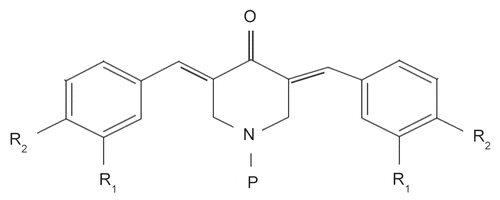Olga A. Issaenko and Alexander Yu Amerik, authors of the recently published paper, "Chalcone-based small-molecule inhibitors attenuate malignant phenotype via targeting deubiquitinating enzymes" wish to make the following clarifications regarding compound names referenced therein.
1. The authors note that on pages 1809 and 1810, the label and the legend for Figure 4B appeared incorrectly in part. Compound name “KVI-14” should instead read “RA-14.”
2. The authors note that small molecule inhibitor RA-9 used in this study is structurally different from another chalcone-derivative “compound 10 RA-9” referenced in 1. To avoid further confusion, in Table 1 below, authors provide chemical formulas, other known names and known references for chalcone-derivatives used in this study.
Acknowledgment
Proprietary rights and synthesis of compounds: inquiries to Saeed R. Khan, The John Hopkins University, Baltimore, Maryland 21231; E-mail: [email protected].
References
- Bazzaro M, Anchoori RK, Mudiam MK, Issaenko O, Kumar S, Karanam B, et al. α,β-Unsaturated carbonyl system of chalcone-based derivatives is responsible for broad inhibition of proteasomal activity and preferential killing of human papilloma virus (HPV) positive cervical cancer cells. J Med Chem 2011; 54:449 - 56; http://dx.doi.org/10.1021/jm100589p; PMID: 21186794
- Issaenko OA, Amerik AY. Chalcone-based small-molecule inhibitors attenuate malignant phenotype via targeting deubiquitinating enzymes. Cell Cycle 2012; 11:1804 - 17; http://dx.doi.org/10.4161/cc.20174; PMID: 22510564
- Anchoori RK, Khan SR, Sueblinvong T, Felthauser A, Iizuka Y, Gavioli R, et al. Stressing the ubiquitin-proteasome system without 20S proteolytic inhibition selectively kills cervical cancer cells. PLoS One 2011; 6:e23888; http://dx.doi.org/10.1371/journal.pone.0023888; PMID: 21909374
